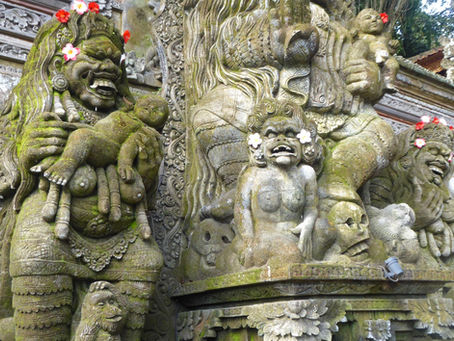top of page

GLOBAL SHANANIGANS

Search


Campuhan Ridge Walk
On the Campuhan Ridge Walk, gentle paths wind past terraced rice fields, jungle valleys and scattered temples. It’s an effortless stroll, yet every step resonates with the echoes of centuries old Balinese culture.
Shannon


Kehen - The Temple of Fire
First mentioned in ancient copper inscriptions from the 9th century, Kehen Temple was originally known as Pura Hyang Api, a sacred site dedicated to Agni, the Hindu God of fire. This powerful deity symbolises not just destruction but also renewal and purification, embodying the transformative force of flame. Over the centuries, the temple underwent several name changes as it evolved with the shifting tides of Balinese history and spirituality.
Shannon


Sacred Monkey Forest Sanctuary
Hidden among dense jungle in Ubud, the Sacred Monkey Forest is a living tapestry of Balinese culture and nature. Ancient Hindu temples rise amid towering banyan trees, creating an atmosphere of quiet reverence. The forest invites visitors to step into a world where spiritual tradition, wildlife and natural beauty coexist seamlessly, offering a rare glimpse into Bali’s enduring heritage.
Shannon


Pura Dalem Ubud - The Temple of Death
In the shadowed heart of Ubud stands Pura Dalem, a temple steeped in ancient power and shadowed secrets. One of the area’s most formidable sacred sites, it pulses at the centre of the local spiritual life, a place where worship, dark rituals and otherworldly performances unfold. Its moss clad stone carvings depict guardian spirits and fearsome deities, whispering of life, death and the unseen forces that linger at the edge of perception.
Shannon


Yeh Pulu - Water of the Stone Jar
Hidden in a lonely ravine between the Petanu and Pakrisan Rivers, the ruins of this unique 14th-century rock relief lay buried for centuries under volcanic eruptions and vegetation. The site was excavated by Dutch authorities in 1925 and in 1949, a stone gutter was cemented on top in order to drain off water, to prevent erosion and vegetation from taking hold, revealing even more of the stone mural.
Shannon


Gunung Kawi Tampaksiring - The Mountain of Lost Kings
Carved into the rock cliffs on both sides of the Pakrisan River, this 11th century temple site and funerary complex is of profound historical and spiritual significance to the Balinese people. The name Gunung Kawi translates to the "Mountain of Poetry" but it is also affectionately referred to as the Valley of the Kings.
Shannon


Ulu Petanu Waterfall
Tucked deep within Tegallalang village, Ulu Petanu Waterfall offers a peaceful, intimate retreat far from Bali’s busy tourist spots, where crystal-clear waters cascade gently amid dense jungle. Steeped in legend, it is also known as the sacred site linked to King Mayadenawa, whose blood is said to have cursed the nearby river, making the waterfall a place of spiritual cleansing and reverence.
Shannon


Besakih Temple
The origins of Pura Besakih are veiled in ancient legend, its story whispered through centuries beyond recorded memory. For more than a thousand years, this sprawling temple complex has stood as the spiritual heart and the “Mother Temple” of the whole island. Perched nearly a kilometre above the sea, on the jagged southwestern flank of Mount Agung, it commands a breathtaking view and an air of sacred power.
Shannon


Goa Garba and the Legacy of Kebo Iwa
Carved into a rugged cliff above the sacred Pakerisan River, this ancient hermitage and unique archaeological site offers a rare glimpse into Bali’s pre Hindu past. Hidden from view, it shelters mysterious megaliths, silent echoes of a time long before Hindu-Buddhist influence shaped the island.
Shannon


Fangs of the Divine - Hanuman the Monkey King
Hanuman, the fierce Monkey King, prowls through the shadowed corners of Balinese myth, a figure both revered and feared. Far beyond a mere symbol of strength, he embodies a primal force, wild, untamed and relentless in his pursuit of justice. In Bali’s ancient Hindu-Buddhist tapestry, Hanuman’s presence evokes a raw energy, one that bridges the mortal world with darker realms where gods and demons wage eternal war.
Shannon


Ayutthaya - The Fallen City of Siam
Once the jewel of Siam, Ayutthaya now lies in silence, its streets soaked in blood and its temples crumbling under the weight of history. Execution grounds, ruined chedis, and desecrated monasteries bear witness to the brutal fall at the hands of the Burmese army, where kings, monks, and nobles met violent ends. The shadows of the city are said to whisper with the voices of the betrayed and the slain, a restless reminder that even in ruin, Ayutthaya’s dark legacy refuses to f
Shannon


Jatiluwih Rice Terraces
The village of Jatiluwih offers a living testament to the ancient harmony between humans, nature and the divine. Overlooked by the brooding silhouette of Mount Batukaru, Bali’s second-highest volcano and a sacred site in its own right, Jatiluwih’s name translates to "truly beautiful," a title it lives up to with dramatic sweeps of emerald-green rice terraces that ripple across the landscape.
Shannon


The Dark Legend of Calon Arang - Bali’s Most Feared Witch
In the black veins of Balinese and Javanese mythos, no figure evokes more dread than Calon Arang. Her story isn’t just about sorcery, it’s about what happens when society pushes a woman too far and she decides to burn the world down rather than be erased by it. She was no mere witch, she became the storm of death incarnate. The widow of Girah and the devourer of life.
Shannon


The Holy Springs of Tirta Empul
Founded in 962AD during the Warmadewa dynasty, Tirta Empul is one of Bali’s most sacred temples, located in the cool highlands of Tampaksiring near Manukaya village. Its name, which means "holy water spring," is derived from a natural spring that bubbles up into the temple’s central pool and continues to feed the nearby Pakerisan River. This revered site is dedicated to Vishnu, the Hindu God of Water and Preservation
Shannon


Ayung River Rafting - Bali's Scenic Waterway
The Ayung River is Bali’s longest waterway, stretching 68.5 km's from the lush northern highlands down to the southern coast at Sanur. It snakes its way through deep gorges, remote jungles, rice terraces and traditional villages, making it one of the island’s most scenic natural features. Despite its size, the Ayung maintains a gentle flow for much of its length, making it ideal for outdoor activities like rafting and river trekking.
Shannon


Garuda - The Immortal Hunter
Garuda, the colossal bird being of Hindu myth, soars through Balinese religious imagination not as a gentle guardian but as a relentless force cutting across the realms of gods, demons and mortals. His wings are said to darken the sky when spread, the violent wind from their beat capable of stripping the leaves from the forests.
Shannon


The Blanco Renaissance Museum
Perched on a ridge above Ubud’s sacred Campuhan River lies one of Bali’s most curious artistic enclaves, the Blanco Renaissance Museum, once the home and studio of the flamboyant artist Don Antonio Blanco. Often called the “Dali of Bali,” Blanco's vibrant persona and sensual art helped solidify his reputation as one of the island's most celebrated foreign creatives.
Shannon


Nusa Lembongan - Bali’s Sister Island
Just 12 kilometres off the southeast coast of Bali lies Nusa Lembongan, a compact gem in a trio of islands that make up part of the Lesser Sunda chain, born from volcanic origins. Though it spans only 8 square km's, the island is a place of striking contrasts and natural beauty. Bright coral reefs encircle the island, while soft white beaches and weathered limestone cliffs shape its edges.
Shannon


Goa Lawah Bat Cave Temple
On Bali’s southeastern coast, Goa Lawah Bat Cave Temple stands out as a powerful spiritual site where myth and nature collide. With thousands of bats roosting above its shrines, this atmospheric temple offers a raw glimpse into the island’s ancient traditions.
Shannon


Cat Cat Village
Cat Cát Village lies in the misty mountains of northern Vietnam, known for its cascading waterfalls, terraced hillsides and narrow stone paths that wind through the valley. The landscape, shaped by water and cloud, gives the village a magical atmosphere that draws travellers seeking both beauty and stillness.
Shannon
bottom of page